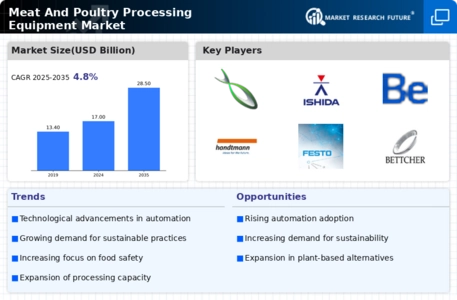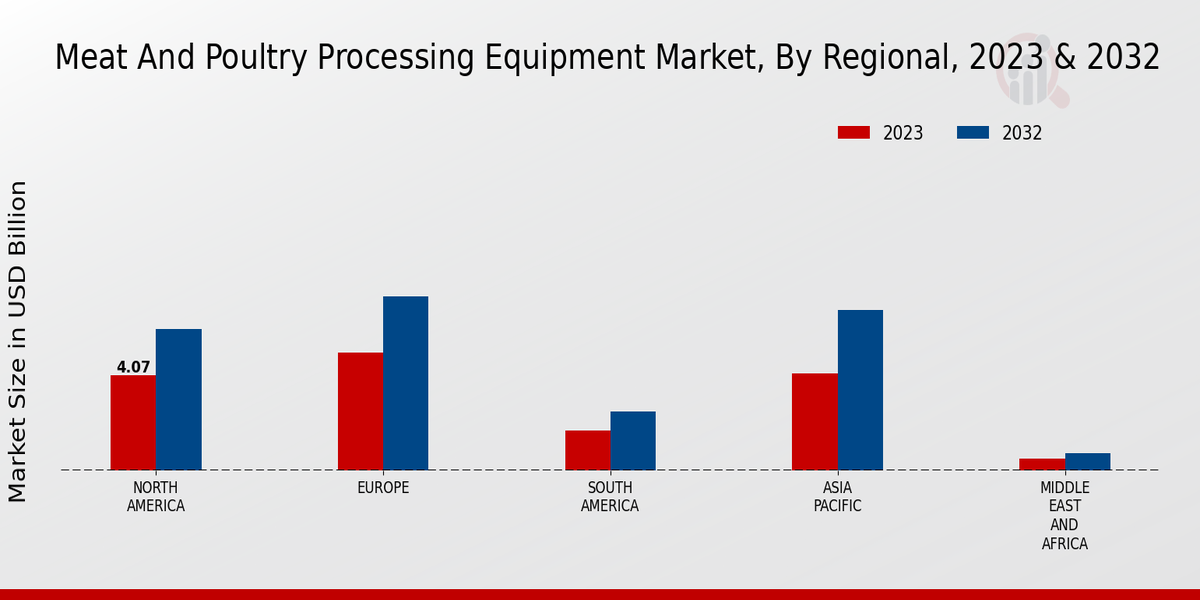Market Growth Projections
The Global Meat And Poultry Processing Equipment Market Industry is projected to experience a compound annual growth rate (CAGR) of 4.82% from 2025 to 2035. This growth trajectory indicates a robust demand for processing equipment driven by various factors, including technological advancements, changing consumer preferences, and regulatory requirements. As the market evolves, stakeholders are likely to focus on innovation and efficiency to capitalize on emerging opportunities. The anticipated growth underscores the importance of strategic investments in processing technologies to meet the increasing demand for high-quality meat products.
Growth of the E-commerce Sector
The rise of e-commerce is reshaping the Global Meat And Poultry Processing Equipment Market Industry by facilitating direct-to-consumer sales of meat products. Online platforms are becoming increasingly popular for purchasing fresh and processed meats, driven by consumer preferences for convenience and variety. This shift is prompting meat processors to enhance their packaging and processing capabilities to meet the demands of online shoppers. As the e-commerce sector continues to expand, it is likely to create new opportunities for equipment manufacturers, leading to increased investments in processing technologies that cater to this evolving market landscape.
Sustainability Trends in Meat Processing
Sustainability is emerging as a key driver in the Global Meat And Poultry Processing Equipment Market Industry. With growing awareness of environmental issues, consumers are increasingly seeking sustainably sourced and processed meat products. This trend is prompting manufacturers to adopt eco-friendly practices and invest in energy-efficient processing equipment. By 2035, the market is expected to grow to 28.5 USD Billion, reflecting the industry's shift towards sustainable practices. Companies that prioritize sustainability are likely to enhance their brand reputation and appeal to environmentally conscious consumers, thereby fostering long-term growth in the market.
Rising Demand for Processed Meat Products
The Global Meat And Poultry Processing Equipment Market Industry is experiencing a surge in demand for processed meat products, driven by changing consumer preferences towards convenience and ready-to-eat meals. In 2024, the market is projected to reach 17.0 USD Billion, reflecting a growing inclination among consumers for high-quality, safe, and easily accessible meat products. This trend is particularly evident in urban areas where busy lifestyles necessitate quick meal solutions. As a result, manufacturers are investing in advanced processing technologies to enhance production efficiency and meet consumer expectations, thereby propelling the growth of the industry.
Increasing Focus on Food Safety Regulations
Food safety regulations are becoming increasingly stringent across the globe, significantly impacting the Global Meat And Poultry Processing Equipment Market Industry. Governments are implementing stricter guidelines to ensure the safety and quality of meat products, which necessitates the adoption of advanced processing equipment. Compliance with these regulations often requires investments in state-of-the-art technology that can enhance traceability and reduce contamination risks. As a result, manufacturers are compelled to upgrade their processing systems, which in turn fuels the demand for innovative equipment solutions, thereby contributing to market expansion.
Technological Advancements in Processing Equipment
Technological innovations play a crucial role in shaping the Global Meat And Poultry Processing Equipment Market Industry. The introduction of automation, robotics, and smart processing solutions is enhancing operational efficiency and product quality. For instance, the integration of Internet of Things (IoT) technology allows for real-time monitoring of processing conditions, ensuring optimal performance and food safety. These advancements not only reduce labor costs but also minimize waste, contributing to sustainability efforts. As the industry evolves, companies that adopt these technologies are likely to gain a competitive edge, further driving market growth.














